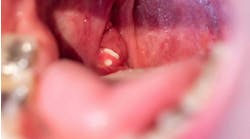by Christine Nathe, RDH, MS
[email protected]
Oral health disparities are found in many communities. People who need dental care the most have difficulty receiving it. One solution to this major issue is delivering dental hygiene services outside of the dental practice. This will help decrease the number of people who do not have access to dental care. One way to bring dental hygiene services to the underserved is to provide dental services in schools. In many states this is accomplished through mobile dental services, a dental hygienist in the school system much like a school nurse, or with dental hygienists joining school–based health–care clinics.
Pecos National Monument. New Mexico Tourism Department/James Orr
Another way to bring dental hygiene to those in need is through the health commons model. The University of New Mexico, Division of Dental Hygiene operates a preventive clinic within a Health Commons in Sandoval County. This program works with the WIC program and County Health Department to provide preventive dental hygiene services to pregnant women and children. The dental hygienists in this practice work as outreach workers, finding restorative dental care for patients in need. Since a UNM dental hygiene faculty member is the provider, dental hygiene students are exposed to a nontraditional dental practice experience, which adds value to the program and increases the likelihood that this model will be duplicated and enhanced in the future.
In this innovative program, a dentist provides exams and consultative services and serves as a bridge between the private dental community and the program. The dental assistant works not only as an assistant, but also fulfills responsibilities as a Community Health Worker within the Sandoval County Health Commons. This allows her to fully integrate the dental program with the other entities. Recently, the dental hygiene clinic has begun providing preventive dental services to Head Start programs in the community.
Dental hygienists should be utilized as outreach workers and case managers, and in order for the dental care to be successful, it should entail the collaboration of all, including dentists, dental hygienists, and dental assistants. Interestingly, dental care is frequently managed on a case–by–case business–type basis and is not effectively positioned as comprehensive health care or practiced in a multidisciplinary fashion.
Preventive dentistry must look back on its inception. Dental hygienists initially had a strong foundation in managing dental care delivery outside of the private dental office. In fact, dental hygiene was created to intercept dental infections before they became too severe to treat, to refer to appropriate health–care providers as needed, and to prevent dental disease in all populations. Essentially, dental hygienists were in the unique position to provide the link to comprehensive oral health care. We need to bring preventive dental care back to the masses.
* I am interested in telling other dental hygienists about your unique program. Please e–mail me at [email protected] and tell me about your program. We'll showcase innovate dental programs that will help all of us bring dental care to the masses!
About the Author
Christine Nathe, RDH, MS, is a professor and graduate program director at the University of Neaw Mexico, Division of Dental Hygiene, in Albuquerque. She is also the author of “Dental Public Health” (www.prenhall.com/nathe), which is in its second edition with Prentice Hall. She can be reached at [email protected] or (505) 272–8147.







